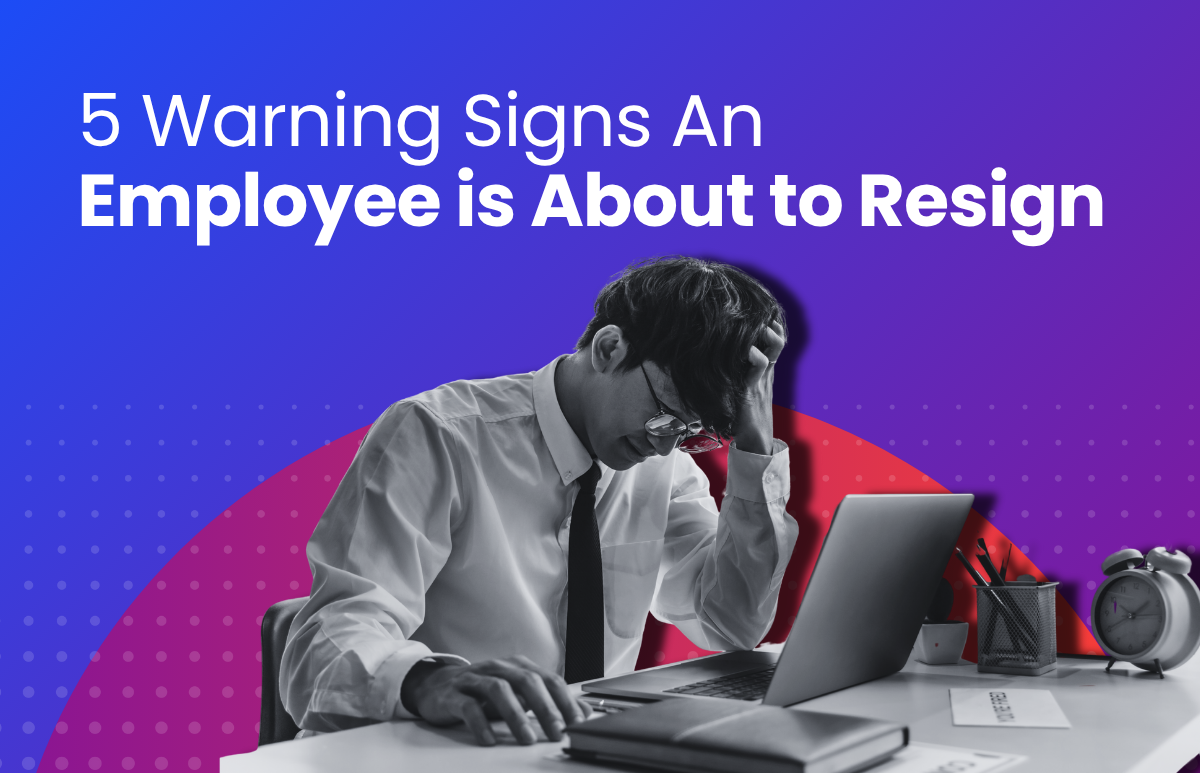5 Warning Signs An Employee is About to Resign
It’s 2025, and while the headlines about the “Great Resignation” have faded, employee turnover remains a real concern for HR professionals across Australia and New Zealand.

According to the April–June 2025 Employee Sentiment Index (ESI), 30% of employees report feeling economically secure, down from 33% in the previous quarter, and 40% say they’ve felt burnt out in the past three months
These insights show that burnout, financial pressure and disengagement are still major risks to retention. For HR leaders, the key is recognising the early warning signs that someone may be ready to move on and taking steps to re-engage them before it’s too late.
Why employees leave and how to stop them wanting to
There are several reasons why an organisation may encounter waning employee loyalty and field more resignations than normal. Some may relate to workload or lack of support from managers and HR. Others may reflect shifting personal priorities such as the desire for flexibility, stability, or work that feels meaningful.
The latest ESI found that remuneration, organisational stability and flexible or remote working remain the top three factors influencing employees when choosing a new employer. These priorities have been consistent for several quarters, suggesting that employees value balance, security and fair reward.
While staff turnover is inevitable and in some cases necessary, employers must do all they can to hold onto their top performers in 2025. Therefore, it is important that they are attuned to the warning signs that suggest an employee is about to call it quits.
Signs that your employees are going to quit
Below are five warning signs to look out for.
1. They are disengaged in their work and in the organisation
When an employee decides they want to change jobs, they often mentally check out of their current one. They may fulfil their duties without protest but no longer show enthusiasm. They may also appear distant in conversations about projects or organisational updates because they no longer see them as relevant.
The ESI shows that fewer than two in five employees (38%) say their organisation has a formal, consistent performance management process, and only two in five (42%) receive helpful feedback often enough to support their motivation and improvement. These insights highlight how inconsistent feedback and unclear expectations can drive disengagement.
Regular, structured check-ins and meaningful feedback can help keep employees connected to their purpose and performance goals. ELMO Performance, for example, helps create structure, consistency and transparency in reviews and development conversations.
2. The quality of their work has declined
Another clue that an employee may be one foot out the door is a decline in their work quality. They may no longer put in the same level of effort or attention to detail because they feel their time with the company is ending.
Frequent and open conversations about goals and development can help managers identify these patterns early and re-energise their team members before dissatisfaction leads to departure.
3. They exhibit poor behaviours
Another telltale sign that an employee may be on their way out is a shift in behaviour. They may display a poor attitude towards their work or team, miss deadlines, or be late to meetings.
Of course, it is important to remember that negative behaviours do not always mean disengagement. An employee might be struggling with personal challenges or burnout. The ESI shows that 37% of employees have worked while feeling unwell and 17% have taken a mental health day in the past three months, underscoring the need for compassion and open dialogue.
Employers should approach these situations with care, creating a safe space for employees to express what they need to feel supported.
4. They become isolated
If an employee begins distancing themselves from colleagues, skipping social interactions or withdrawing from team discussions, it could indicate they are no longer emotionally invested in the organisation.
A sense of belonging is critical to engagement. The ESI found that three in four employees (74%) feel recognised for their contributions at work. Recognition and connection go hand in hand. Even small gestures of appreciation can help employees feel valued and reinvigorated.
ELMO Rewards and Recognition helps organisations create a culture of appreciation that strengthens connection and belonging.
5. They take more days off
An employee who is preparing to leave may start taking more personal or sick days, possibly to attend interviews or simply disconnect from the workplace.
While employers should not jump to conclusions, a noticeable increase in absences can prompt a meaningful conversation about wellbeing, motivation and workload.
With 40% of employees reporting burnout this year, regular one on one check-ins can be a powerful way to re establish engagement and support. These conversations may even encourage an employee to stay.
How to retain your employees
It is critical that employers understand what employees want and need when it comes to driving retention efforts.
The ELMO Employee Sentiment Index shows that employee’s top priorities are:
- Remuneration and bonus payments / incentives
- Stability of an organisation
- Flexible / Remote work
So when it comes to improving retention, this is a good place to start. Other practices that help employees feel valued and in turn increase retention include the following.
Create a culture of recognition and feedback
It’s been a challenging few years and it is vital that employers recognise the hard work and achievements of their people. Recognition, feedback and clear communication are key to keeping teams motivated and engaged.
Creating a performance based rem structure through a tool like ELMO Remuneration is another great way to demonstrate that their work is valued.
Improve performance management processes
When employees feel undervalued, their loyalty can fade. Strengthening performance management processes builds trust and engagement and ensures top performers feel appreciated.
Build a positive workplace culture
The culture of an organisation shapes how employees interact and the atmosphere they experience day to day. Employers can build a healthy culture by improving communication, recognition and opportunities for growth. These pillars are key to developing and retaining your top performers and preparing your organisation for whatever 2026 brings.
 HR Core
HR Core 









